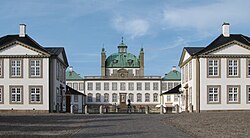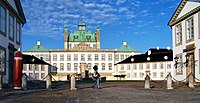
Christiansborg Palace is a palace and government building on the islet of Slotsholmen in central Copenhagen, Denmark. It is the seat of the Danish Parliament, the Danish Prime Minister's Office, and the Supreme Court of Denmark. Also, several parts of the palace are used by the Danish monarch, including the Royal Reception Rooms, the Palace Chapel and the Royal Stables.

Frederiksborg Castle is a palatial complex in Hillerød, Denmark. It was built as a royal residence for King Christian IV of Denmark-Norway in the early 17th century, replacing an older castle acquired by Frederick II and becoming the largest Renaissance residence in Scandinavia. On three islets in the Slotssøen, it is adjoined by a large formal garden in the Baroque style.

The Royal Palace in Oslo was built in the first half of the 19th century as the Norwegian residence of the French-born Charles XIV John, who reigned as king of Norway and Sweden. The palace is the official residence of the current Norwegian monarch while the Crown Prince resides at Skaugum in Asker west of Oslo.

Frederiksberg Palace is a Baroque residence, located in Frederiksberg, Denmark, adjacent to the Copenhagen Zoo. It commands a view over Frederiksberg Gardens, originally designed as a palace garden in the Baroque style. Constructed and extended from 1699 to 1735, the palace served as the royal family’s summer residence until the mid-19th century. Since 1869, it has housed the Royal Danish Military Academy.

Frederiksberg Gardens is one of the largest and most attractive greenspaces in Copenhagen, Denmark. Together with the adjacent Søndermarken it forms a green area of 64 hectares at the western edge of Inner Copenhagen. It is a romantic landscape garden designed in the English style.

Hirschholm Palace, also known as Hørsholm Palace, was a royal palace located in present-day Hørsholm municipality just north of Copenhagen, Denmark. It was rebuilt in the Baroque style in the 1740s and, one of the finest buildings of its time, it became known as the "Versailles of the North".
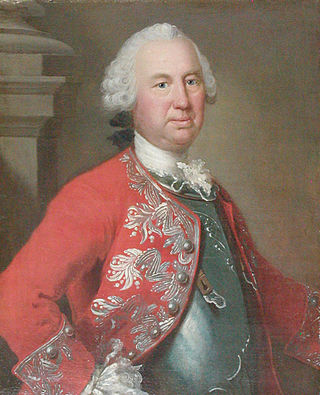
Laurids Lauridsen de Thurah, known as Lauritz de Thurah, was a Danish architect and architectural writer. He became the most important Danish architect of the late baroque period. As an architectural writer and historian he made a vital contribution to the understanding of both Denmark's architectural heritage and building construction in his day.
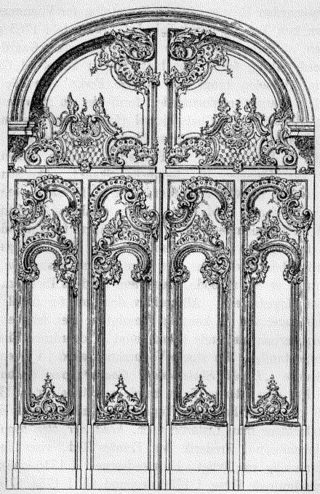
Nicolai Eigtved, also known as Niels Eigtved, was a Danish architect. He introduced and was the leading proponent of the French rococo or late baroque style in Danish architecture during the 1730s–1740s. He designed and built some of the most prominent buildings of his time, a number of which still stand to this day. He also played an important role in the establishment of the Royal Danish Academy of Art, and was its first native-born leader.
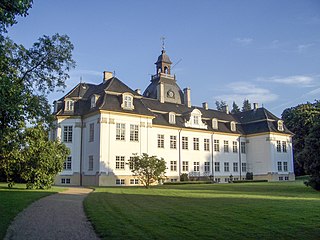
Charlottenlund Palace is a former royal summer residence in Charlottenlund, some 10 km (6 mi) north of central Copenhagen, Denmark. The palace was named after Princess Charlotte Amalie, who was responsible for the construction of the original palace. It was later extended and adapted for Crown Prince Frederick VIII to a design by Ferdinand Meldahl in the early 1880s.

Bygdøy Royal Estate, also known as the Bygdø Royal Farm, is a Kongsgård estate and manor house that occupies a large part of the northwestern part of the Bygdøy peninsula in Oslo, Norway. It is the official summer residence of the king of Norway.

Gråsten Palace is located at Gråsten in the Jutland region of southern Denmark. It is best known for being the summer residence of the Danish royal family. The main house has a modern, all-white facade, with Venetian doors opening onto sweeping, manicured lawns and gravel walkways. The grounds include a huge stables court.

The architecture of Denmark has its origins in the Viking Age, revealed by archaeological finds. It was established in the Middle Ages when first Romanesque, then Gothic churches and cathedrals, were built throughout the country. During this period, brick became the construction material of choice for churches, fortifications and castles, as the country had little access to stone.

Sorgenfri Palace is a royal residence of the Danish monarch, located in Lyngby-Taarbæk Municipality, on the east side of Lyngby Kongevej, in the northern suburbs of Copenhagen. The surrounding neighbourhood is called Sorgenfri after it. Only the cellar and foundations survive of the first Sorgenfri House, which was built in 1705 to design by François Dieussart. The current house was built in 1756 by Lauritz de Thurah and later adapted and extended by Peter Meyn in the 1790s. Lauritz de Thurah has also designed buildings which flank the driveway closer to the road.

North Zealand, also North Sealand, refers to the northern part of the Danish island of Zealand which is not clearly defined but generally covers the area north of Copenhagen. The Danish tourist authorities have recently introduced the term Danish Riviera to cover the area in view of its increasing importance for tourism. The area has three royal castles and offers resorts with beaches, as well as lakes and forests. In addition to Kronborg Castle, three of the North Zealand forest areas used for royal par force hunting are included in the UNESCO World Heritage List.
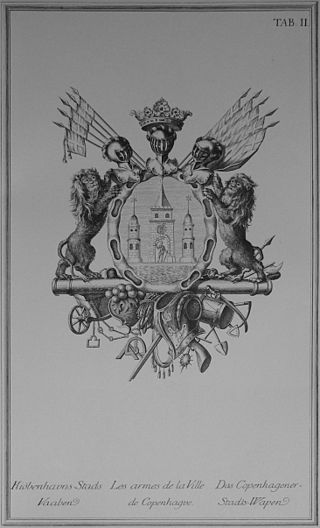
Den Danske Vitruvius is a richly illustrated 18th-century architectural work on Danish monumental buildings of the period, written by the Danish Baroque architect Lauritz de Thurah. It was commissioned by Christian VI in 1735 and published in two volumes between 1746 and 1749. The title refers to the Roman architect and engineer Vitruvius, who published De architectura in the 1st century AD, an authoritative treatise on the architecture of the time. The direct inspiration for de Thurah's Den Danske Vitruvius was Colen Campbell's Vitruvius Britannicus.

Jacob Fortling was a German-Danish sculptor, architect and industrialist, described as one of the most industrious people in the Denmark of his day. He came to Denmark at age 18 and embarked on a successful career, first as a sculptor and later also as an architect. He was also engaged in the production of building materials, owning several quarries in Norway. Just outside Copenhagen, on Amager's east coast, he founded Kastrup Værk, a large industrial facility combining a lime plant, a brickyard and a pottery.

Roskilde Mansion, also known as Roskilde Palace and as the Yellow Mansion, is a former royal Baroque mansion in central Roskilde, Denmark. Located just east of Roskilde Cathedral, it now houses both an exhibition venue and the office and official residence of the Bishop of Roskilde.

Skipperhuset refers to a small cluster of historic buildings including an 18th-century former royal boathouse located in Fredensborg Palace gardens on the southeastern shoreline of Lake Esrum at Fredensborg, Denmark. The buildings are now home to the Lake Esrum Boat Service and a restaurant.

The park of Frederiksborg Castle is located to the north and west of Frederiksborg Castle in Hillerød, Denmark. It consists of a formal Baroque garden and a Romantic landscape garden.
